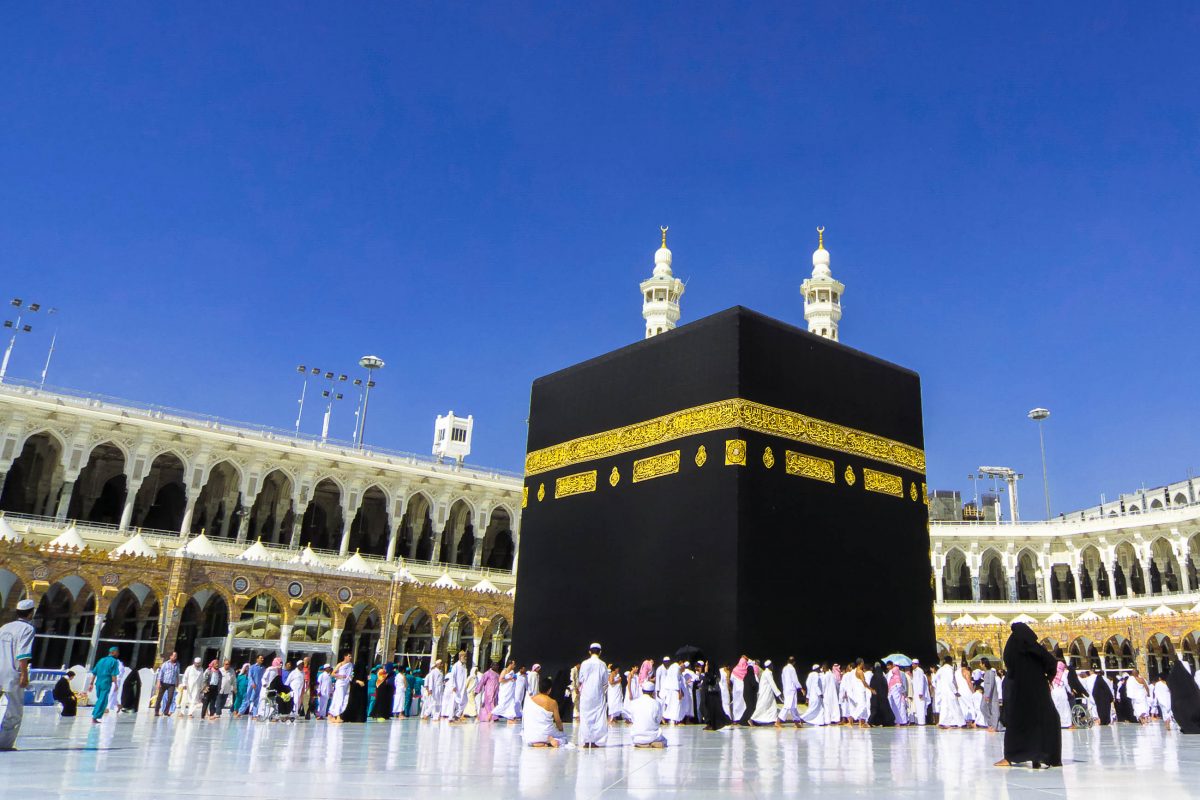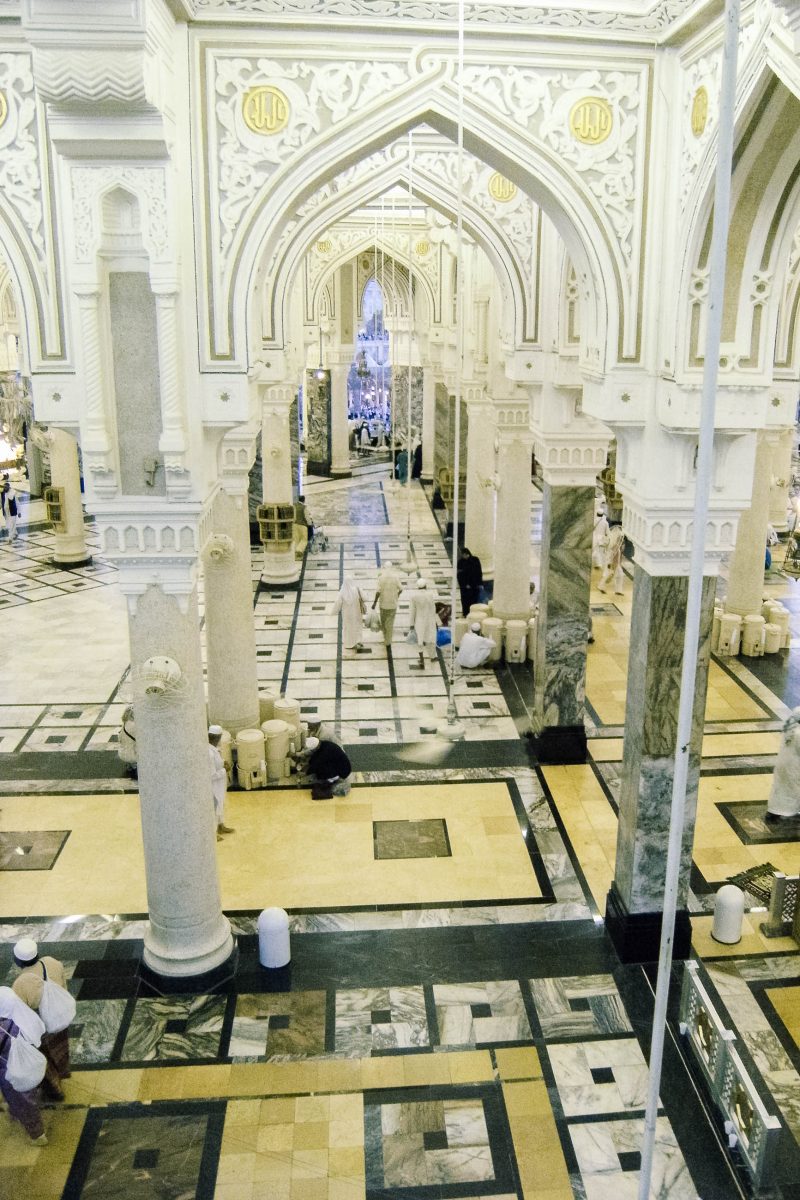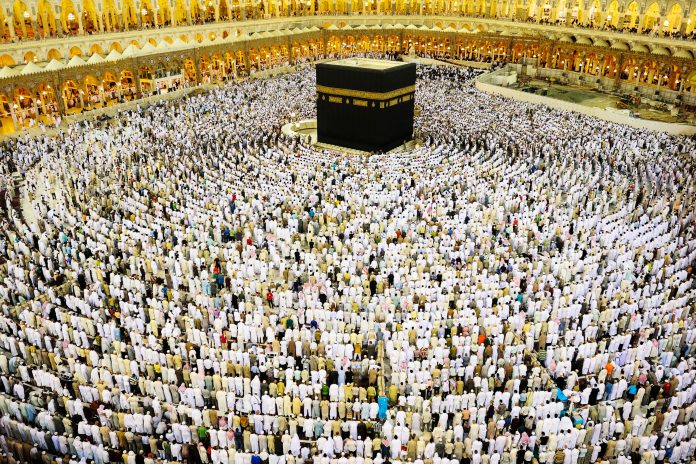Die al-Haram-Moschee in Mekka ist die heiligste Moschee des Islam und jedes Jahr Ziel von Millionen von Pilgern. In ihrem Innenhof befindet sich die Kaaba, jener Schrein, der die Richtung muslimischer Gebete auf der ganzen Welt bestimmt.
Die al-Haram-Moschee in Mekka, Saudi-Arabien, dem Geburtsort des Propheten Mohammed, ist die heiligste Stätte des Islam und größte Moschee der Welt. Nach ihr richten sich alle Muslime auf der ganzen Welt aus, wenn sie ihr Gebet sprechen. Sie gehört gemeinsam mit der Prophetenmosche ein Medina und der al-Aqsa-Moschee in Jerusalem zu den drei heiligsten Orten des Islam.
Inhaltsverzeichnis
BILDER: Al-Haram-Moschee in Mekka
Fotogalerie: Al-Haram-Moschee in Mekka
Kaaba und der Schwarze Stein
Im riesigen Innenhof der al-Haram-Moschee befindet sich die Kaaba, jenes Allerheiligste, in dessen Richtung alle muslimischen Gebete gesprochen werden und die Mihrabs (Gebetsnischen) aller Moscheen der Welt ausgerichtet sind. Wegen diesem und um diesen unscheinbaren schwarzen Würfel aus Granit wurde die gesamte Moschee errichtet.
Die allererste Kaaba wurde angeblich von Adam, dem ersten Menschen, als Haus für Gott auf Erden gebaut. Dem Koran zufolge wurde die heutige Kaaba von Abraham und seinem Sohn Ismail errichtet, unter anderem mit dem mysteriösen Schwarzen Stein.
Dieser liegt bis heute in der Kaaba und stellt seit der Zeit des Propheten Mohammed eine wichtige Reliquie des islamischen Glaubens dar. Manche Muslime halten den Schwarzen Stein für einen gewöhnlichen Stein, andere wiederum schreiben ihm Heilkräfte zu und die Macht, Sünden zu vergeben.

Ihren schwarzen Umhang erhielt die Kaaba Ende des 7. Jahrhunderts von den Abbasiden. Die „kiswa“ besteht aus einem Vorhang an jeder Seite und wird jedes Jahr erneuert. Der goldene Schriftzug ist ein Teil des muslimischen Glaubensbekenntnisses: „Es gibt keinen Gott außer Allah und Mohammed ist sein Prophet.“
Das Innere der Kaaba ist mit Marmor ausgelegt und mit Gold und Silber dekoriert. Das Umschreiten und Beten an der Kaaba gehört zu den höchsten religiösen Handlungen, die ein Muslim durchführen kann. Laut Mohammed ist ein Gebet in der al-Haram-Moschee hunderttausende Gebete an einem anderen Ort wert (außer in der Al-Aqsa- und der Prophetenmoschee).
Brunnen Zamzam
Neben der Kaaba befindet sich noch der Brunnen Zamzam im Innenhof der Masjia al-Haram. Der islamischen Überlieferung zufolge soll Allah diese Quelle entspringen lassen haben, um die ägyptische Sklavin Hagar und ihren Sohn Ismail, den ersten Sohn Abrahams und Prophet und Gesandten Gottes, in der Wüste vor dem Verdursten zu retten.
Auf der Suche nach Wasser war Hagar zuvor zwischen den beiden Bergen Al-Safa und Al-Marwa siebenmal hin und her gelaufen – ein Weg, der sich heute zu einem Pilgerbrauch entwickelt hat. Die Quelle des Brunnens Zamzam soll angeblich auch der Grund für die Entstehung von Mekka gewesen sein. Der Großvater des Propheten Mohammed hat die Quelle der Überlieferung zufolge wieder entdeckt, nachdem sie in Vergessenheit geraten war.
Das Wasser des Zamzam soll seinen Ursprung direkt im Paradies und somit heilende Wirkung haben. Das Trinken des Wassers ist ein zur Pilgerreise zugehöriges Ritual. Jeder Pilger nimmt 10-20 Liter Zamzam-Wasser von seiner Pilgerreise mit nach hause. Der kommerzielle Handel mit dem heiligen Wasser ist verboten und das Mitnehmen von echtem Zamzam-Wasser ins Ausland ist nur unter strengen Kontrollen in eingeschweißten Kanistern möglich.
Haddsch – die Pilgerreise nach Mekka

Die fünfte Säule des Islam besagt, dass jeder freie, volljährige und gesunde Muslim, der es sich leisten kann, einmal in seinem Leben die Pilgerreise nach Mekka, Haddsch genannt, antreten solle.
Dies ist immer nur zu bestimmten Zeiten möglich und zwar im Dhu l-hiddscha, dem zwölften und letzten Monat im muslimischen Kalenders (meist im September oder Oktober, je nachdem wann in Mekka die Mondsichel gesichtet wird). Die Zahl der Pilger, die nach Mekka reisen, steigt jedes Jahr, mittlerweile sind es bereits über zwei Millionen.
Die Moschee von Mekka umfasst zwar eine Gebetsfläche von 356.800 Quadratmetern, auf dieser finden jedoch „nur“ bis zu 820.000 Gläubige Platz. Und doch ist das immer noch zu wenig für die Menschenmassen, die während des religiösen Großereignisses in die Stadt strömen. Die Veranstalter werden immer wieder vor eine neue Herausforderung gestellt, denn derart viele Besucher wollen auch versorgt und untergebracht werden.
Geschichte der al-Haram-Moschee
Bereits in vorislamischer Zeit bestand die al-Haram-Moschee aus der Kaaba, dem Zamzam-Brunnen und dem Maqām Ibrahim, einem Felsen, der Abrahams Fußabdruck zeigt. Um 630 nach Christus ließ der Prophet Mohammed die erste Moschee errichten, die jedoch bald zu klein wurde und von den nachfolgenden Völkern der Umayyaden, Abbasiden, Mamluken, Osmanen und schließlich den Saudis über die Jahrhunderte erweitert wurde.

Der Großteil des heutigen Gebäudes stammt aus der umfassenden Renovierung, die der osmanische Sultan Selim II. im Jahr 1571 anordnete. Damaliger Architekt war niemand geringerer als der Meister Sinan, der auch die Selimiye-Moschee in der türkischen Stadt Edirne für den Sultan entwarf.
Die letzte große Erweiterung der al-Haram Moschee finanzierte König Fahd Ende des 20. Jahrhunderts, zu der unter anderem auch die Klimatisierung der Moschee gehörte.
Erweiterung der al-Haram-Moschee in Mekka
Die al-Haram-Moschee musste dringend erneut ausgebaut werden. Ein Projekt dazu ist bereits seit 2007 im Gange. Bei Abschluss des Ausbaus soll sich die Moschee in einem Umkreis von 660 Metern um die Kaaba erstrecken, 2 Minarette mehr haben und 2,5 Millionen Menschen Platz bieten. Das gewaltige Projekt kostet 80 Milliarden Saudi-Rial, das sind rund 20 Milliarden Euro!
Die Erweiterung der al-Haram-Moschee wurde kontrovers diskutiert, da dafür einige Gebäude von hohem historischen Wert abgerissen werden müssen. Bei einem Kransturz durch ein Unwetter wurden am 11. September 2015 über 100 Menschen getötet und mehr als 200 weitere verletzt.
Kein Zugang für Nicht-Muslime: Nicht-Muslimen ist der Zutritt in die gesamte Stadt Mekka – und damit auch in die al-Haram-Moschee – nicht gestattet. Nicht umsonst bedeutet „al-Haram“ „die Verwehrte“.





